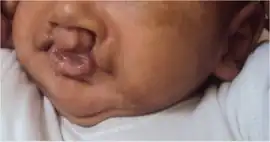Popliteal pterygium syndrome
| Popliteal pterygium syndrome | |
|---|---|
 | |
| Popliteal pterygium syndrome is inherited in an autosomal dominant pattern. | |
Popliteal pterygium syndrome (PPS) is an inherited condition affecting the face, limbs, and genitalia.[1] The syndrome goes by a number of names including the popliteal web syndrome and, more inclusively, the facio-genito-popliteal syndrome. The term PPS was coined by Gorlin et al.. in 1968 on the basis of the most unusual anomaly, the popliteal pterygium (a web behind the knee).[2]
Symptoms and signs

Clinical expressions of PPS are highly variable, but include the following:[3][4][5]
- Limb findings: an extensive web running from behind the knee down to the heel (90%), malformed toenails, and webbed toes.
- Facial findings: cleft palate with or without cleft lip (75%), pits in the lower lip (40%), fibrous bands in the mouth known as syngnathia (25%), and tissue connecting the upper and lower eyelids
- Genital findings (50%): hypoplasia of the labia majora, malformation of the scrotum, and cryptorchidism.
Genetics
The genetic locus for PPS was localized to chromosome 1 in 1999. The disorder is inherited in an autosomal dominant manner and is due to mutation of the IRF6 gene. Most reported cases are sporadic; advanced parental age is found in a number of these cases, suggesting new mutations.
The term PPS has also been used for two rare autosomal recessively inherited conditions: Lethal PPS and PPS with Ectodermal Dysplasia. Although both conditions feature a cleft lip/palate, syngnathia, and popliteal pterygium, they are clinically distinguishable from the autosomal dominant case. Lethal PPS is differentiated by microcephaly, corneal aplasia, ectropion, bony fusions, hypoplastic nose and absent thumbs, while PPS with Ectodermal Dysplasia is differentiated by woolly hair, brittle nails, ectodermal anomalies, and fissure of the sacral vertebrae.[6]
Relationship to Van der Woude syndrome
Van der Woude syndrome (VDWS) and popliteal pterygium syndrome (PPS) are allelic variants of the same condition; that is, they are caused by different mutations of the same gene. PPS includes all the features of VDWS, plus popliteal pterygium, syngnathia, distinct toe/nail abnormality, syndactyly, and genito-urinary malformations.[7]
Diagnosis
The diagnosis of Popliteal pterygium syndrome is established on certain physical features and molecular genetic testing.[8]
Treatment
Popliteal pterygium syndrome treatment entails cleft lip surgery. Additionally, speech therapy, audiological and dental assessments will need to be addressed for the individual.[9]
Epidemiology
The diagnosis of PPS has been made in several ethnic groups, including Caucasian, Japanese, and sub-Saharan African. Males and females are equally likely to suffer from the syndrome. Since the disorder is very rare, its incidence rate is difficult to estimate, but is less than 1 in 10,000.[10]
See also
References
- ↑ James, William; Berger, Timothy; Elston, Dirk (2005). Andrews' Diseases of the Skin: Clinical Dermatology (10th ed.). Saunders. p. 577. ISBN 978-0-7216-2921-6.
- ↑ Gorlin RJ, Sedano HO, Cervenka J (February 1968). "Popliteal pterygium syndrome . A syndrome comprising cleft lip-palate, popliteal and intercrural pterygia, digital and genital anomalies". Pediatrics. 41 (2): 503–9. PMID 4384166. Archived from the original on 2008-10-11. Retrieved 2020-11-29.
- ↑ "medterms.com". Archived from the original on 2014-05-23. Retrieved 2020-11-29.
- ↑ Parikh SN, Crawford AH, Do TT, Roy DR (May 2004). "Popliteal pterygium syndrome: implications for orthopaedic management". J Pediatr Orthop B. 13 (3): 197–201. doi:10.1097/01202412-200405000-00010. PMID 15083121.
- ↑ "Archive copy". Archived from the original on 2020-09-19. Retrieved 2020-11-29.
{{cite web}}: CS1 maint: archived copy as title (link) - ↑ Cardoso ER, Hawary MB, Mahmud S (April 1998). "A recessively inherited non-lethal form of popliteal pterygium syndrome". Br J Oral Maxillofac Surg. 36 (2): 138–40. doi:10.1016/s0266-4356(98)90183-8. PMID 9643601.
- ↑ Wong FK, Hagg U (October 2004). "An update on the aetiology of orofacial clefts". Hong Kong Med J. 10 (5): 331–6. PMID 15479962. Archived from the original on 2021-03-02. Retrieved 2020-11-29.
- ↑ "IRF6-Related Disorders". NORD (National Organization for Rare Disorders). Archived from the original on 19 February 2017. Retrieved 31 July 2021.
- ↑ RESERVED, INSERM US14-- ALL RIGHTS. "Orphanet: Autosomal dominant popliteal pterygium syndrome". www.orpha.net. Archived from the original on 26 October 2019. Retrieved 31 July 2021.
- ↑ Froster-Iskenius UG (May 1990). "Popliteal pterygium syndrome". J. Med. Genet. 27 (5): 320–6. doi:10.1136/jmg.27.5.320. PMC 1017084. PMID 2352260.
External links
| Classification | |
|---|---|
| External resources |
|